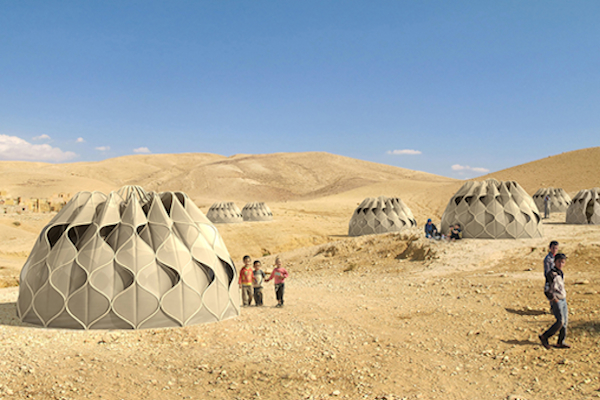A sustainable tent that collects rainwater, folds up for easy transport and stores solar energy? Sounds visionary, right? This is the invention of Jordanian-Canadian architect, designer and artist Abeer Seikaly. Abeer Seikaly designed these amazing multipurpose tents with refugees in mind, people who have been displaced by global and civil war, climate change and more. Inspired by elements of nature such as snake skin and traditional cultural aspects such as weaving, nomadic life and tent dwellings, this weather proof, strong but lightweight and mobile fabric tent gives refugees shelter but also a chance to “weave their lives back together”. The flexible dual layer tent structure has the ability to close out the cold of winter and wet weather. It also opens up to allow cool air in and hot air out in summer. Rainwater is collected in the top of the tent and filters down the sides so the tent does not become flooded. The tent also has the ability to become a showering facility with water being stored in pockets on the side and drawn upwards via a thermosiphoning system providing basic sanitation. Solar energy hits the tent fabric and is stored in a battery for use at night […]
Continue reading... →Ray Anderson often asked a rhetorical question: does business exist to make a profit, or does business make a profit to exist? With this line of questioning, Ray called upon us to understand that while making a profit is the lifeblood of a company’s survival, it shouldn’t be the only reason for a company to exist.
With his talent for translating lofty vision into everyday reality, Ray would ask: what you would rather get out of bed to do each day: make carpet, or make history?
Making history by making carpet is a unifying sentiment for the people of Interface. How, exactly, are we making history? By proving the business model for sustainability, while taking on Ray’s challenge to eliminate our negative environmental footprint.
Ray believed there must be a better way for business to thrive on our planet, without the assumed ecological and social impacts that our current industrial take-make-waste system creates. With such ambitious goals, where do we look for inspiration in redesigning a system as pervasive and complex as business?
Continue reading... →Podcast: Play in new window | Download
Subscribe: RSS
When Zem Joaquin’s two children suffered from chronic asthma, she took it in her own hands and undertook a major renovation in her home — and her life. “I was frustrated by the fact that both of my children were constantly being hospitalized. I was up so many nights with a nebulizer in hand with crying children,” she painfully remembers. “The pediatricians just kept saying that it was part of childhood, that many children have asthma.” But after they recommended putting her children on long-term steroids, she said, “Enough is enough!”
Continue reading... →April is landscape architecture month. What do you think about the shaping of our relationship to the natural world?
Continue reading... →
